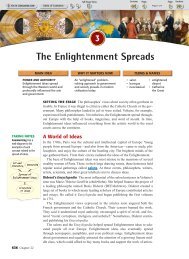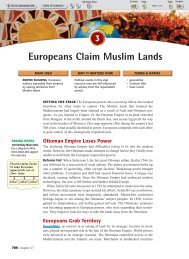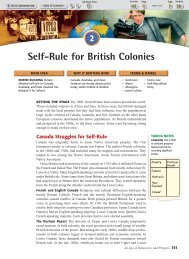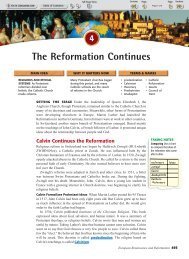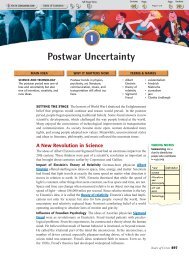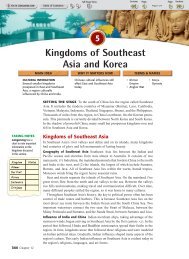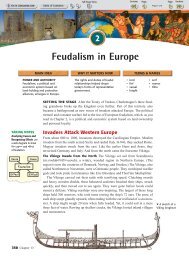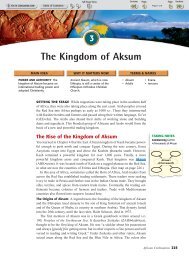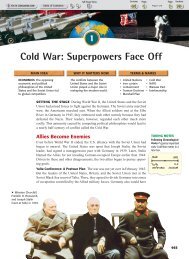The Beginnings of Industrialization - Euro-webonline.com
The Beginnings of Industrialization - Euro-webonline.com
The Beginnings of Industrialization - Euro-webonline.com
You also want an ePaper? Increase the reach of your titles
YUMPU automatically turns print PDFs into web optimized ePapers that Google loves.
1<br />
<strong>The</strong> <strong>Beginnings</strong> <strong>of</strong> <strong>Industrialization</strong><br />
MAIN IDEA WHY IT MATTERS NOW TERMS & NAMES<br />
SCIENCE AND TECHNOLOGY<br />
<strong>The</strong> Industrial Revolution started<br />
in England and soon spread to<br />
other countries.<br />
<strong>The</strong> changes that began in<br />
Britain paved the way for<br />
modern industrial societies.<br />
• Industrial<br />
Revolution<br />
• enclosure<br />
• crop rotation<br />
• industrialization<br />
• factors <strong>of</strong><br />
production<br />
• factory<br />
• entrepreneur<br />
SETTING THE STAGE In the United States, France, and Latin America, political<br />
revolutions brought in new governments. A different type <strong>of</strong> revolution now<br />
transformed the way people worked. <strong>The</strong> Industrial Revolution refers to the<br />
greatly increased output <strong>of</strong> machine-made goods that began in England in the<br />
middle 1700s. Before the Industrial Revolution, people wove textiles by hand.<br />
<strong>The</strong>n, machines began to do this and other jobs. Soon the Industrial Revolution<br />
spread from England to Continental <strong>Euro</strong>pe and North America.<br />
Industrial Revolution Begins in Britain<br />
In 1700, small farms covered England’s landscape. Wealthy landowners, however,<br />
began buying up much <strong>of</strong> the land that village farmers had once worked.<br />
<strong>The</strong> large landowners dramatically improved farming methods. <strong>The</strong>se innovations<br />
amounted to an agricultural revolution.<br />
<strong>The</strong> Agricultural Revolution Paves the Way After buying up the land <strong>of</strong> village<br />
farmers, wealthy landowners enclosed their land with fences or hedges. <strong>The</strong><br />
increase in their landholdings enabled them to cultivate larger fields. Within<br />
these larger fields, called enclosures, landowners experimented with more productive<br />
seeding and harvesting methods to boost crop yields. <strong>The</strong> enclosure<br />
movement had two important results. First, landowners tried new agricultural<br />
methods. Second, large landowners forced small farmers to be<strong>com</strong>e tenant farmers<br />
or to give up farming and move to the cities.<br />
Jethro Tull was one <strong>of</strong> the first <strong>of</strong> these scientific farmers. He saw that the<br />
usual way <strong>of</strong> sowing seed by scattering it across the ground was wasteful. Many<br />
seeds failed to take root. He solved this problem with an invention called the seed<br />
drill in about 1701. It allowed farmers to sow seeds in well-spaced rows at specific<br />
depths. A larger share <strong>of</strong> the seeds took root, boosting crop yields.<br />
Rotating Crops <strong>The</strong> process <strong>of</strong> crop rotation proved to be one <strong>of</strong> the best developments<br />
by the scientific farmers. <strong>The</strong> process improved upon older methods <strong>of</strong><br />
crop rotation, such as the medieval three-field system discussed in Chapter 14.<br />
One year, for example, a farmer might plant a field with wheat, which exhausted<br />
soil nutrients. <strong>The</strong> next year he planted a root crop, such as turnips, to restore<br />
nutrients. This might be followed in turn by barley and then clover.<br />
TAKING NOTES<br />
Following Chronological<br />
Order On a time line,<br />
note important events in<br />
Britain‘s industrialization.<br />
1700 1830<br />
<strong>The</strong> Industrial Revolution 717
An English<br />
farmer plants his<br />
fields in the early<br />
1700s using a<br />
seed drill.<br />
▲<br />
Livestock breeders improved their methods too. In the 1700s, for example,<br />
Robert Bakewell increased his mutton (sheep meat) output by allowing only his<br />
best sheep to breed. Other farmers followed Bakewell’s lead. Between 1700 and<br />
1786, the average weight for lambs climbed from 18 to 50 pounds. As food supplies<br />
increased and living conditions improved, England’s population mushroomed.<br />
An increasing population boosted the demand for food and goods such as cloth. As<br />
farmers lost their land to large enclosed farms, many became factory workers.<br />
Why the Industrial Revolution Began in England In addition to a large population<br />
<strong>of</strong> workers, the small island country had extensive natural resources.<br />
<strong>Industrialization</strong>, which is the process <strong>of</strong> developing machine production <strong>of</strong><br />
goods, required such resources. <strong>The</strong>se natural resources included<br />
•water power and coal to fuel the new machines<br />
• iron ore to construct machines, tools, and buildings<br />
•rivers for inland transportation<br />
• harbors from which merchant ships set sail<br />
In addition to its natural resources, Britain had an expanding economy to support<br />
industrialization. Businesspeople invested in the manufacture <strong>of</strong> new inventions.<br />
Britain’s highly developed banking system also contributed to the country’s industrialization.<br />
People were encouraged by the availability <strong>of</strong> bank loans to invest in<br />
new machinery and expand their operations. Growing overseas trade, economic<br />
prosperity, and a climate <strong>of</strong> progress led to the increased demand for goods.<br />
Britain’s political stability gave the country a tremendous advantage over its<br />
neighbors. Though Britain took part in many wars during the 1700s, none occurred<br />
on British soil. <strong>The</strong>ir military successes gave the British a positive attitude.<br />
Parliament also passed laws to help encourage and protect business ventures. Other<br />
countries had some <strong>of</strong> these advantages. But Britain had all the factors <strong>of</strong> production,<br />
the resources needed to produce goods and services that the Industrial<br />
Revolution required. <strong>The</strong>y included land, labor, and capital (or wealth).<br />
Recognizing<br />
Effects<br />
How did population<br />
growth spur<br />
the Industrial<br />
Revolution?<br />
Inventions Spur <strong>Industrialization</strong><br />
In an explosion <strong>of</strong> creativity, inventions now revolutionized industry. Britain’s<br />
textile industry clothed the world in wool, linen, and cotton. This industry was the<br />
first to be transformed. Cloth merchants boosted their pr<strong>of</strong>its by speeding up the<br />
process by which spinners and weavers made cloth.<br />
Changes in the Textile Industry As you will learn in the feature on textile technology<br />
on page 719, by 1800, several major inventions had modernized the cotton<br />
industry. One invention led to another. In 1733, a machinist named John Kay made<br />
a shuttle that sped back and forth on wheels. This flying shuttle, a boat-shaped piece<br />
718 Chapter 25
Textiles Industrialize First<br />
<strong>The</strong> Industrial Revolution that began in Britain was spurred by a<br />
revolution in technology. It started in the textile industry, where<br />
inventions in the late 1700s transformed the manufacture <strong>of</strong> cloth.<br />
<strong>The</strong> demand for clothing in Britain had greatly increased as a<br />
result <strong>of</strong> the population boom caused by the agricultural revolution.<br />
<strong>The</strong>se developments, in turn, had an impact worldwide. For<br />
example, the consumption <strong>of</strong> cotton rose dramatically in Britain<br />
(see graph at right). This cotton came from plantations in the<br />
American South, where cotton production skyrocketed from<br />
1790 to 1810 in response to demand from English textile mills.<br />
John Kay’s flying<br />
shuttle (below)<br />
speedily carried<br />
threads <strong>of</strong> yarn<br />
back and forth<br />
when the weaver<br />
pulled a handle on<br />
the loom. <strong>The</strong><br />
flying shuttle<br />
greatly increased<br />
the productivity<br />
<strong>of</strong> weavers.<br />
▲<br />
▲ Flying<br />
shuttle<br />
British Cotton Consumption, 1800–1900<br />
Cotton Consumption (in thousands <strong>of</strong> metric tons)<br />
1000<br />
900<br />
800<br />
700<br />
600<br />
500<br />
400<br />
300<br />
200<br />
100<br />
0<br />
1800<br />
1810 1820 1830<br />
1840 1850 1860 1870 1880 1890 1900<br />
Source: <strong>Euro</strong>pean Historical Statistics, 1750–1975<br />
Patterns <strong>of</strong> Interaction<br />
Technology Transforms an Age: <strong>The</strong><br />
Industrial and Electronic Revolutions<br />
Inventions in the textile industry started in Britain<br />
and brought about the Industrial Revolution. This<br />
revolution soon spread to other countries. <strong>The</strong><br />
process <strong>of</strong> industrialization is still spreading around<br />
the world, especially in developing countries. A<br />
similar technological revolution is occurring in<br />
electronics today, transforming the spread <strong>of</strong><br />
information around the world.<br />
1. Synthesizing How might the<br />
technological innovation and<br />
industrialization that took place in<br />
the textile industry during the<br />
Industrial Revolution have provided<br />
a model for other industries?<br />
See Skillbuilder Handbook, Page R21.<br />
2. Recognizing Effects Research the<br />
textile industry today to learn how it<br />
has been affected by new technology,<br />
including <strong>com</strong>puterization. Prepare a<br />
two-paragraph summary on the<br />
effects <strong>of</strong> the new technology.<br />
719
Inventions in America<br />
In the United States, American inventors worked at making<br />
railroad travel more <strong>com</strong>fortable, inventing adjustable<br />
upholstered seats. <strong>The</strong>y also revolutionized agriculture, manufacturing,<br />
and <strong>com</strong>munications:<br />
1831 Cyrus McCormick’s reaper boosted American wheat<br />
production.<br />
1837 Samuel F. B. Morse, a New England painter, first sent<br />
electrical signals over a telegraph.<br />
1851 I. M. Singer improved the sewing machine by inventing a<br />
foot treadle (see photograph).<br />
1876 Scottish-born inventor Alexander Graham Bell patented<br />
the telephone.<br />
INTERNET ACTIVITY Create a photo exhibit on<br />
American inventions <strong>of</strong> the 19th century. Include<br />
the name <strong>of</strong> the inventor and the date with each<br />
photograph. Go to classzone.<strong>com</strong> for your research.<br />
<strong>of</strong> wood to which yarn was attached, doubled the work a weaver could do in a day.<br />
Because spinners could not keep up with these speedy weavers, a cash prize<br />
attracted contestants to produce a better spinning machine. Around 1764, a textile<br />
worker named James Hargreaves invented a spinning wheel he named after his<br />
daughter. His spinning jenny allowed one spinner to work eight threads at a time.<br />
At first, textile workers operated the flying shuttle and the spinning jenny by<br />
hand. <strong>The</strong>n, Richard Arkwright invented the water frame in 1769. This machine<br />
used the waterpower from rapid streams to drive spinning wheels. In 1779, Samuel<br />
Crompton <strong>com</strong>bined features <strong>of</strong> the spinning jenny and the water frame to produce<br />
the spinning mule. <strong>The</strong> spinning mule made thread that was stronger, finer, and<br />
more consistent than earlier spinning machines. Run by waterpower, Edmund<br />
Cartwright’s power loom sped up weaving after its invention in 1787.<br />
<strong>The</strong> water frame, the spinning mule, and the power loom were bulky and expensive<br />
machines. <strong>The</strong>y took the work <strong>of</strong> spinning and weaving out <strong>of</strong> the house.<br />
Wealthy textile merchants set up the machines in large buildings called factories.<br />
Factories needed waterpower, so the first ones were built near rivers and streams:<br />
Summarizing<br />
What inventions<br />
transformed the<br />
textile industry?<br />
PRIMARY SOURCE<br />
A great number <strong>of</strong> streams . . . furnish water-power adequate to turn many hundred<br />
mills: they afford the element <strong>of</strong> water, indispensable for scouring, bleaching, printing,<br />
dyeing, and other processes <strong>of</strong> manufacture: and when collected in their larger<br />
channels, or employed to feed canals, they supply a superior inland navigation, so<br />
important for the transit <strong>of</strong> raw materials and merchandise.<br />
EDWARD BAINS, <strong>The</strong> History <strong>of</strong> Cotton Manufacture in Great Britain (1835)<br />
England’s cotton came from plantations in the American South in the 1790s.<br />
Removing seeds from the raw cotton by hand was hard work. In 1793, an American<br />
inventor named Eli Whitney invented a machine to speed the chore. His cotton gin<br />
multiplied the amount <strong>of</strong> cotton that could be cleaned. American cotton production<br />
skyrocketed from 1.5 million pounds in 1790 to 85 million pounds in 1810.<br />
720 Chapter 25
Improvements in Transportation<br />
Progress in the textile industry spurred other industrial improvements. <strong>The</strong><br />
first such development, the steam engine, stemmed from the search for a cheap,<br />
convenient source <strong>of</strong> power. As early as 1705, coal miners were using steampowered<br />
pumps to remove water from deep mine shafts. But this early model <strong>of</strong> a<br />
steam engine gobbled great quantities <strong>of</strong> fuel, making it expensive to run.<br />
Watt’s Steam Engine James Watt, a mathematical instrument maker at the<br />
University <strong>of</strong> Glasgow in Scotland, thought about the problem for two years. In<br />
1765, Watt figured out a way to make the steam engine work faster and more efficiently<br />
while burning less fuel. In 1774, Watt joined with a businessman named<br />
Matthew Boulton. Boulton was an entrepreneur (AHN•truh•pruh•NUR), a person<br />
who organizes, manages, and takes on the risks <strong>of</strong> a business. He paid Watt a salary<br />
and encouraged him to build better engines.<br />
Water Transportation Steam could also propel boats. An American inventor<br />
named Robert Fulton ordered a steam engine from Boulton and Watt. He built a<br />
steamboat called the Clermont, which made its first successful trip in 1807. <strong>The</strong><br />
Clermont later ferried passengers up and down New York’s Hudson River.<br />
In England, water transportation improved with the creation <strong>of</strong> a network <strong>of</strong><br />
canals, or human-made waterways. By the mid-1800s, 4,250 miles <strong>of</strong> inland channels<br />
slashed the cost <strong>of</strong> transporting both raw materials and finished goods.<br />
Road Transportation British roads improved, too, thanks largely to the efforts <strong>of</strong><br />
John McAdam, a Scottish engineer. Working in the early 1800s, McAdam equipped<br />
road beds with a layer <strong>of</strong> large stones for drainage. On top, he placed a carefully<br />
smoothed layer <strong>of</strong> crushed rock. Even in rainy weather heavy wagons could travel<br />
over the new “macadam” roads without sinking in mud.<br />
Private investors formed <strong>com</strong>panies that built roads and then operated them for<br />
pr<strong>of</strong>it. People called the new roads turnpikes because travelers had to stop at tollgates<br />
(turnstiles or turnpikes) to pay tolls before traveling farther.<br />
<strong>The</strong> Railway Age Begins<br />
Steam-driven machinery powered English factories in the late 1700s. A steam<br />
engine on wheels—the railroad lo<strong>com</strong>otive—drove English industry after 1820.<br />
Steam-Driven Lo<strong>com</strong>otives In 1804, an English engineer named Richard<br />
Trevithick won a bet <strong>of</strong> several thousand dollars. He did this by hauling ten tons <strong>of</strong><br />
iron over nearly ten miles <strong>of</strong> track in a steam-driven lo<strong>com</strong>otive. Other British engineers<br />
soon built improved versions <strong>of</strong> Trevithick’s lo<strong>com</strong>otive. One <strong>of</strong> these early<br />
▼ First-class<br />
passengers on<br />
the Liverpool-<br />
Manchester<br />
Railway in the<br />
1830s rode<br />
in covered<br />
cars; all others,<br />
in open cars.<br />
<strong>The</strong> Industrial Revolution 721
▲ George<br />
Stephenson’s<br />
Rocket<br />
railroad engineers was George Stephenson. He had gained a solid reputation<br />
by building some 20 engines for mine operators in northern<br />
England. In 1821, Stephenson began work on the world’s first railroad<br />
line. It was to run 27 miles from the Yorkshire coal fields to the port <strong>of</strong><br />
Stockton on the North Sea. In 1825, the railroad opened. It used four<br />
lo<strong>com</strong>otives that Stephenson had designed and built.<br />
<strong>The</strong> Liverpool-Manchester Railroad News <strong>of</strong> this success quickly<br />
spread throughout Britain. <strong>The</strong> entrepreneurs <strong>of</strong> northern England<br />
wanted a railroad line to connect the port <strong>of</strong> Liverpool with the<br />
inland city <strong>of</strong> Manchester. <strong>The</strong> track was laid. In 1829, trials were<br />
held to choose the best lo<strong>com</strong>otive for use on the new line. Five<br />
engines entered the <strong>com</strong>petition. None could <strong>com</strong>pare with the<br />
Rocket, designed by Stephenson and his son.<br />
Smoke poured from the Rocket’s tall smokestack, and its two pistons<br />
pumped to and fro as they drove the front wheels. <strong>The</strong> lo<strong>com</strong>otive<br />
hauled a 13-ton load at an unheard-<strong>of</strong> speed—more than 24<br />
miles per hour. <strong>The</strong> Liverpool-Manchester Railway opened <strong>of</strong>ficially<br />
in 1830. It was an immediate success.<br />
Railroads Revolutionize Life in Britain <strong>The</strong> invention and perfection<br />
<strong>of</strong> the lo<strong>com</strong>otive had at least four major effects. First, railroads<br />
spurred industrial growth by giving manufacturers a cheap way to transport materials<br />
and finished products. Second, the railroad boom created hundreds <strong>of</strong> thousands<br />
<strong>of</strong> new jobs for both railroad workers and miners. <strong>The</strong>se miners provided<br />
iron for the tracks and coal for the steam engines. Third, the railroads boosted<br />
England’s agricultural and fishing industries, which could transport their products<br />
to distant cities.<br />
Finally, by making travel easier, railroads encouraged country people to take distant<br />
city jobs. Also, railroads lured city dwellers to resorts in the countryside. Like<br />
a lo<strong>com</strong>otive racing across the country, the Industrial Revolution brought rapid and<br />
unsettling changes to people’s lives.<br />
Synthesizing<br />
How did<br />
improvements in<br />
transportation promote<br />
industrialization<br />
in Britain?<br />
SECTION<br />
1<br />
ASSESSMENT<br />
TERMS & NAMES 1. For each term or name, write a sentence explaining its significance.<br />
• Industrial Revolution • enclosure • crop rotation • industrialization • factors <strong>of</strong> production • factory • entrepreneur<br />
USING YOUR NOTES<br />
2. Which <strong>of</strong> the events listed do<br />
you think was the most<br />
important? Explain.<br />
1700 1830<br />
MAIN IDEAS<br />
3. What were four factors that<br />
contributed to industrialization<br />
in Britain?<br />
4. How did rising population help<br />
the Industrial Revolution?<br />
5. What American invention aided<br />
the British textile industry?<br />
CRITICAL THINKING & WRITING<br />
6. EVALUATING Was the revolution in agriculture necessary<br />
to the Industrial Revolution? Explain.<br />
7. MAKING INFERENCES What effect did entrepreneurs have<br />
upon the Industrial Revolution?<br />
8. FORMING AND SUPPORTING OPINIONS Do you agree or<br />
disagree with the statement that the steam engine was<br />
the greatest invention <strong>of</strong> the Industrial Revolution? Why?<br />
9. WRITING ACTIVITY SCIENCE AND TECHNOLOGY Write a<br />
letter, as a British government <strong>of</strong>ficial during the<br />
Industrial Revolution, to an <strong>of</strong>ficial in a nonindustrial<br />
nation explaining how the railroad has changed Britain.<br />
CONNECT TO TODAY CREATING AN ILLUSTRATED NEWS ARTICLE<br />
Find information on a recent agricultural or technological invention or improvement. Write a<br />
two-paragraph news article about its economic effects and include an illustration, if possible.<br />
722 Chapter 25



